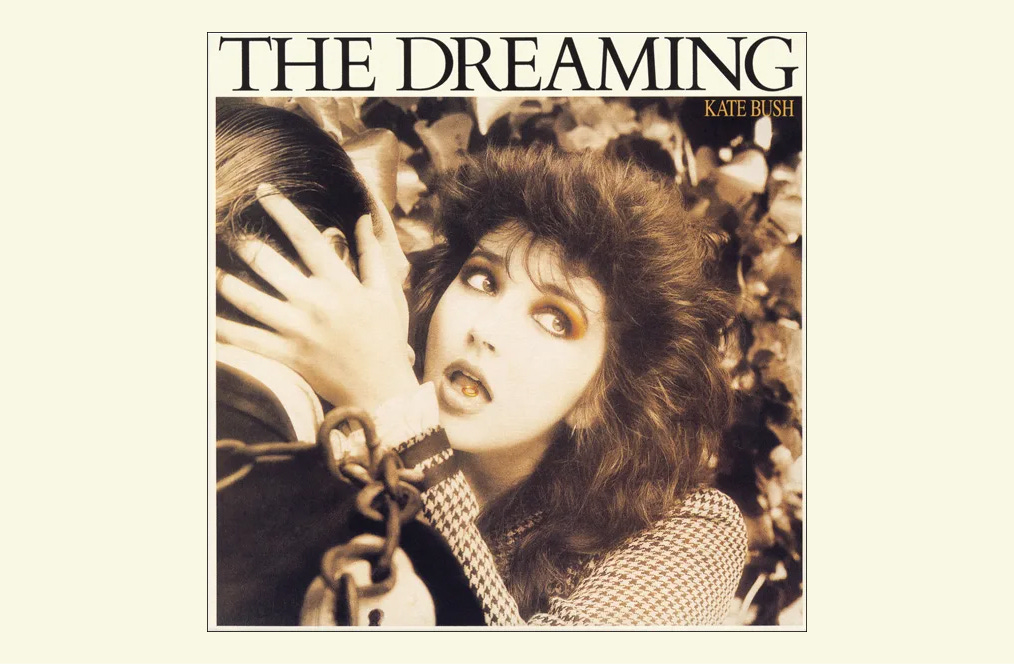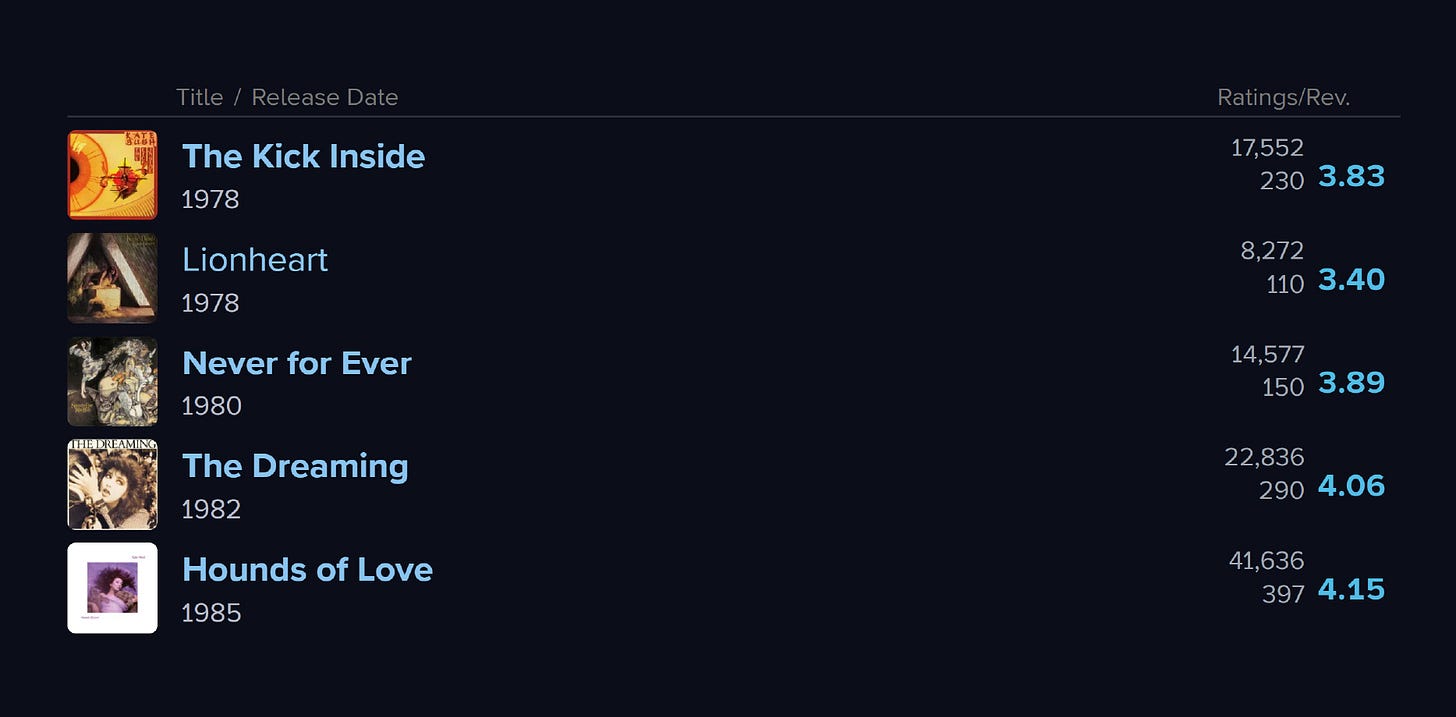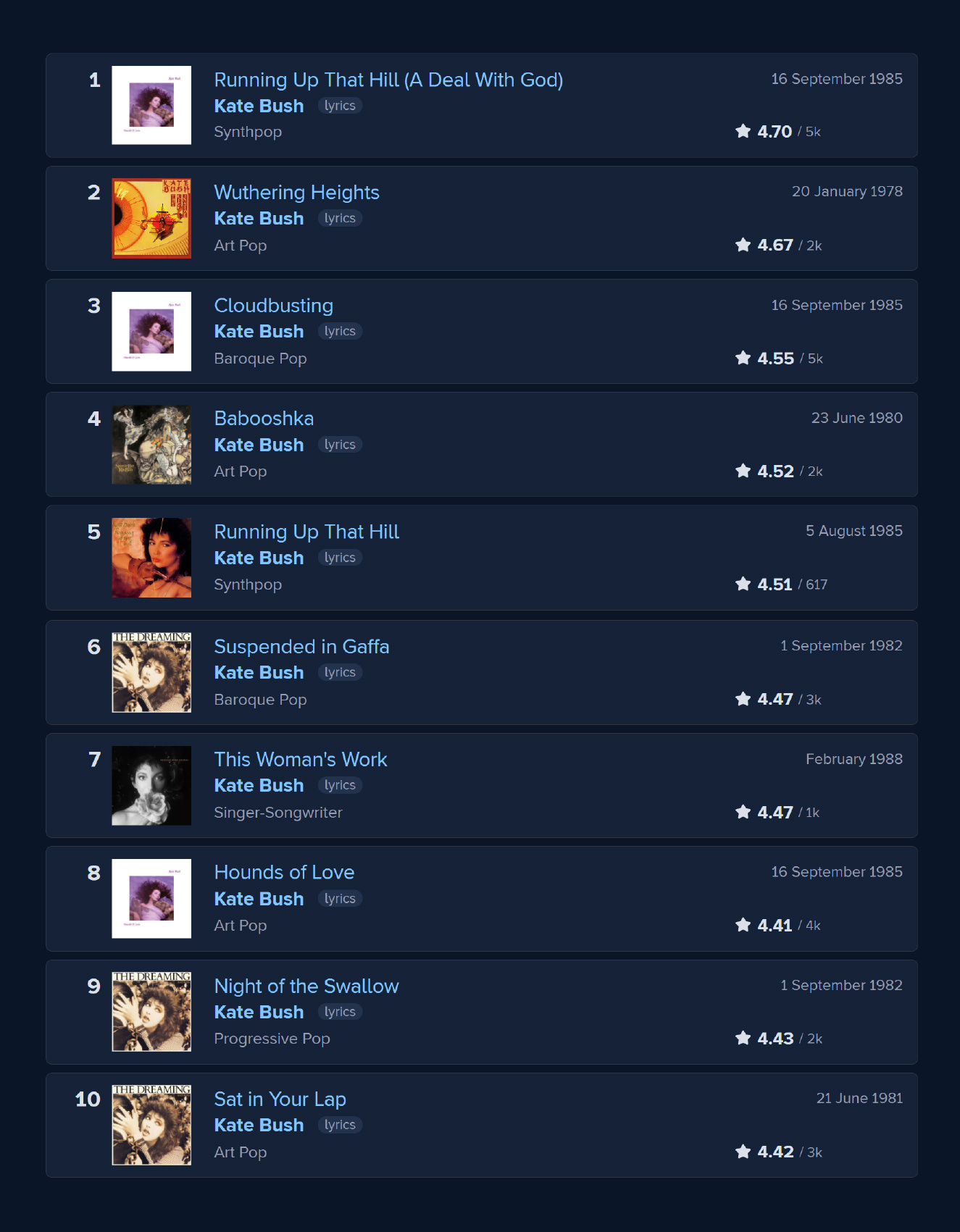Album Round-up: The Dreaming
Revisiting the unheralded fourth studio masterpiece by Britain's most beloved art-pop starlet.
In America, the name Kate Bush is synonymous with her 1985 single “Running Up That Hill,” the lead-off track from her fifth studio album, Hounds of Love. While this song was a moderate hit in the U.S. four decades ago—reaching No. 30 on the Billboard Hot 100 in November of that year1—it wasn’t considered an enduring work.
It was merely an aside, underscoring how this Brit’s illustrious career in her native country couldn’t be replicated abroad. That is, until 37 years later—in 2022. “Running Up That Hill” reentered the spotlight that summer—and the Billboard singles chart, too—peaking at No. 3 the week of July 30th.2
The song found new life through its prominent role in the fourth season of the hit Netflix series Stranger Things, introducing Bush—and the rest of her musical catalogue—to an entirely new generation of fans.
But this article isn’t examining Bush’s resurgence—or the song or album that surrounds it, for that matter. While Hounds of Love is almost universally considered her crowning achievement, it wasn’t the pop starlet’s first brush with stardom—not by a long shot.
Wuthering Heights
Kate Bush was discovered by none other than David Gilmour of Pink Floyd. After hearing her demos—some written when she was as young as 13—he became her greatest champion, and at his urging, she was signed to EMI Records in 1975.
In January 1978, she released her first single from her debut album, The Kick Inside. The song was called “Wuthering Heights,” which Bush had written the year before—at the age of 18—in a single evening.
It’s an incredibly bewildering composition, with unusual harmonic progressions, irregular phrase lengths, and vocals—featuring lyrics inspired by the 19th-century novel of the same name—sung entirely in falsetto. Yet its eccentricities became its strengths, as the song became a hit far beyond Bush’s wildest dreams.
“Wuthering Heights” reached No. 1 on the U.K. charts in early March, where it stayed for four weeks.3 With this, Bush made history as the first female artist to top the British charts with an entirely self-written song.4 She became a cultural phenomenon in her home country—and easily the most photographed woman of the year.5
A Hidden Gem
Unfortunately—while incredibly captivating and inspiring—this article isn’t about Bush’s debut either. Much has been written about this legendary female artist’s colossally unforeseen rise—and her recent, equally surprising peak almost five decades later.
However, her work in the in-between years of 1979 to 1984 is less explored—but equally deserving of attention. So today, we’ll be revisiting Bush’s fourth studio album—the predecessor to Hounds of Love, neatly sandwiched between her two most notable years: 1982’s The Dreaming.
The In-between Years
Lionheart
Kate Bush’s debut studio album, The Kick Inside, went to No. 3—and ended up spending an astounding 71 weeks on the U.K. charts.
But the newly crowned popstar refused to rest on her laurels—she returned to the recording studio that summer, and her follow-up album, Lionheart, was released that November.
This record wasn’t as well received as its predecessor and didn’t have a hit single like “Wuthering Heights”—though it still reached No. 6.6
It should be said, the Bush herself wasn’t satisfied with the finished product, feeling it rushed by her label, EMI, in an effort to capitalize on her rapid rise to stardom.
Never for Ever
In September 1980, her third studio album, Never for Ever, was released. In many ways, it was the true successor to The Kick Inside, complete with its own standout track: “Babooshka”—although “Army Dreamers” is my personal favorite.
The record snagged the top spot on the U.K. charts for the week of September 20th—becoming the first of Bush’s two No. 1 studio albums.7
RateYourMusic
For a critical assessment of these early years—turning once again to RateYourMusic, the premier source for community-driven album ratings—we find the following scores for her albums:
Discounting the hurried Lionheart, Bush’s early discography follows an impressively solid upward trajectory—culminating in 1985.
The Kick Inside and Never for Ever rank as the 13th and 5th best records of 1978 and 1980, respectively. Her follow-up—and today’s subject—The Dreaming, was the 3rd best of 1982. And Bush’s magnum opus, Hounds of Love, claimed the top album of its release year: 1985.
Sorting by Songs
Another nifty feature of this site is its ability to display ratings and rankings for individual songs. For Bush, two tracks—the aforementioned “Running Up That Hill” and “Wuthering Heights” occupy her top spots—by a vast margin, too.
In fact, these two songs are the 29th and 96th highest rated tracks on the entire site— out of a database of 25,442,159 songs at the time of writing.
For a band to have even one song grace the coveted top 100 list is an honor—let alone two, and by a solo artist, no less.
Among Bush’s highest-rated songs, tracks from her album The Dreaming are unique: though none rank among her top five, all ten are clustered remarkably close together.
Three appear in her top ten, seven in her top twenty-five, and all ten within her top thirty-three.
So, even without an exceptionally enduring entry—like “Running Up That Hill,” “Wuthering Heights,” or “Babooshka”—The Dreaming earns the title of Bush’s most consistently high-quality album: its weakest track still outranks three from Hounds of Love.
Production
While Bush shared production duties with Jon Kelly on Never for Ever, on The Dreaming she elected to produce the record entirely on her own. As a direct result, its composition was destined to be even more disparate than her already eccentric discography.
At the album’s helm was the Fairlight CMI—a digital synth, sampler, and audio workstation, essentially a Logic Pro or GarageBand for the early ‘80s. This versatile little machine would later see its most famous use as the driver force behind “Running Up That Hill.”
On The Dreaming, Bush used it to fill in the production gaps—chiefly enabling the looped and reversed vocals that characterize the record, as well as its occasional dream-like atmosphere.
An Odd Analysis
The Dreaming, more so than any of Kate Bush’s other work, showcases the full versatility of her artistry.
Usually, at this point in an album retrospective, I would assess each track individually. Yet The Dreaming is just so in effable, so unqualifiable, that this task is nearly impossible. Instead, I will discuss this album’s quirks on a general level. There are many common threads—which we’ll explore in detail.
With every track on the album, so much happens in such a short span. In this vein, it resembles the heavily layered, dream-like textures of The Beatles’ Magical Mystery Tour.
Vocal loop upon vocal loop is hurled at the listener—a barrage of samples spoofing gangster noir films on “There Goes a Tenner,” freakish animal noises on the closer “Get Out of My House,” and even a snippet of Stravinsky’s Firebird on “The Dreaming.”8
Its production is over the top—dramatic to no end—yet simultaneously, it draws inspiration from the austere traditions of English, Celtic, and Aboriginal folk music.
On the record’s title track, Bush explores the latter of these cultures. Driven mostly by didgeridoo—her piano finally gets a break—“The Dreaming” a feast of looped and reversed sounds that pop out from a ghostly void. Bush’s fake Aussie accent grow increasingly tiring—but still, points for originality.
As for drama, “There Goes a Tenner” has all the makings of a Broadway—or more aptly, West End—play: a heist gone wrong, complete with Bush’s finest Michael Caine-style Cockney accent.
Then, all of a sudden, it turns ethereal—like a day dream, courtesy of a vapory synth. Neil Tennant agreed: “Very weird… Obviously she’s trying to become less accessible. Even so this has a haunting atmosphere.”9 I suppose that’s a compliment…
The music video for “There Goes a Tenner” is a treat—Bush looks star so wide-eyed and cheery, you’d almost think she wrote the song just to film it.
The Little Quirks
Each song on The Dreaming has a calling card—an odd sample of Bush’s falsetto, looped throughout. They range from the scream of “And love life!” on “Pull Out the Pin” to the cryptic “But now I've started learning how”—apparently—on “Leave It Open.”
In all honesty, I had to look up what most of these lyrics were. To me—and I assume most listeners—they’re just curious noises that heighten these already incredible songs.
However, the clear winner for memorability is “Suspended in Gaffa,” with its pleading refrain: “I want it all.” Arguably the best track on the record, it’s a tapestry of bygone instruments—mandolin, strings, and antique-sounding Synclavier.
I imagine this song as a young girl’s dream, unfolding in a fantasy world as she roams the English countryside—her “mindy moors.”
But really, it’s about “being given a glimpse of God”10 and the frustration of never being able to reach it again without a lot of hard work—real heady stuff.
The “gaffa” in “Suspended in Gaffa” refers to the tape used by musicians. Our protagonist is stuck—suspended in this tape—between her starting place and her goal of reaching God.
Genre-blurring
If I were to attempt to categorize this type of music—having no true companion among other musicians—I’d call it theatrical maximalism. But really, that label applies more to its spirit than its instrumentation.
But for many, the term baroque pop, referencing Bush’s integration of orchestral instruments, would also suffice.
It’s all really out there—to say the least—and Bush truly pushes the boundaries of what can be considered “pop music,” as just about everything about these ten songs is about as far from the mainstream as anything I’ve written about on this Substack.
So really, it’s extremely puzzling why Kate Bush was blessed with the gift of instant—and very prolonged—mainstream success.
A Record for the Masses
The Dreaming was an immediate, modest hit in the U.K., released on September 13th, 1982, and entering the charts at No. 3 the week of September 25th—one and three spots above Yazoo’s Upstairs at Eric’s and Simple Minds’ New Gold Dream (81–82–83–84), respectively.11
As for singles, the record boasted a whopping five: “Sat in Your Lap,” “The Dreaming,” “There Goes a Tenner,” “Suspended in Gaffa,” and “Night of the Swallow,” which was released a full year after the others—and only in Ireland.12
The lead-off track, “Sat In Your Lap,” performed far and away the best—reaching No. 1113—while “The Dreaming” reached only No. 48,14 and “There Goes a Tenner,” No. 93.15 The other two singles didn’t chart at all.
Curiously, The Dreaming’s success seems to owe itself to a gestalt mindset on the part of the British listener—the whole was greater than the sum of its parts. There was no smash hit or standout track like her past works—just ten excellent, low-key songs.
There’s no need to mention its performance in America either, as it was basically nonexistence—the record peaked at No. 157 on the Billboard 200.16
Bush would have to wait another three years to finally see some well-deserved success on the other side of the Atlantic.
Stage-shy
Bush didn’t tour at all to support her album. In fact, quite shockingly, she has only gone on tour once in her entire career: The Tour of Life, in the spring of 1979—which lasted just 28 shows over six weeks.17
This is an utter rarity for a musician—especially a “pop” star who has enjoyed such intense and prolonged success for almost half a century.
However, the complexity of her compositions and her propensity for theatrics make performing live an incredibly tall task. Just look at one of her performances of “Wuthering Heights” from that fabled tour—how tiring and awkward must that have been.
So, it’s rather easy to excuse Bush for not wanting to go through that again.
A Final Word
Almost 43 years later, The Dreaming sounds just as otherworldly as it did the day it was released—without parallel.
It remains, perhaps, the best-kept secret of an artist long accustomed to the spotlight—one who dared to push the boundaries of what pop music is, and what it could become.
If there’s one takeaway from this record, it’s first that the human voice is the most powerful instrument, and second, that a return to an old sound—a really old sound—can be just as novel and disruptive.
Baroque has never felt so cutting-edge.
https://www.billboard.com/charts/hot-100/1985-11-30/
https://www.billboard.com/artist/kate-bush/chart-history/hsi/
https://www.officialcharts.com/songs/kate-bush-wuthering-heights/
https://www.theguardian.com/music/2020/may/19/the-100-greatest-uk-no-1s-no-14-kate-bush-wuthering-heights#:~:text=When%20it%20saw%20the%20light,and%20the%20fates%20were%20aligned.&text=If%20playback%20doesn't%20begin%20shortly%2C%20try%20restarting%20your%20device.
https://www.theguardian.com/music/2010/may/13/kate-bush-only-tour-live
https://www.officialcharts.com/albums/kate-bush-lionheart/
https://www.officialcharts.com/albums/kate-bush-never-for-ever/
https://genius.com/Kate-bush-the-dreaming-sample/samples
https://www.katebushencyclopedia.com/there-goes-a-tenner
http://gaffa.org/cloud/music/suspended_in_gaffa.html
https://www.officialcharts.com/albums/kate-bush-the-dreaming/
http://gaffa.org/discog/singles/notshoud.html
https://www.officialcharts.com/songs/kate-bush-sat-in-your-lap/
https://www.officialcharts.com/songs/kate-bush-the-dreaming/
https://imgur.com/G29Jpul
https://www.billboard.com/artist/kate-bush/chart-history/tlp/
https://www.loudersound.com/features/kate-bush-tour-of-life







